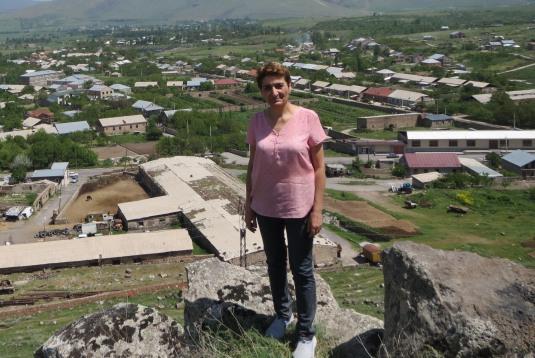Each of the national rituals is a musical-theatrical performance which begins in the church and ends with a community festivity with interesting activities taking place. Some of them develop and get into process, and sometimes they are resolved finding their solution. Most of the activities and relationships are accompanied with music. So they have all the characteristics of an opera.
In this case, the plot of the opera was the Feast of Ascension. There is a heartfelt expectation in the heart of each participant when listening to fortune-telling or reading a specifically chosen part of the future predictive book. Young girls are preparing for this ritual with special conscientiousness and love. They bring water from seven springs, collect seven stones and pick up seven different flowers. To cast lots they make bride dolls, wreaths and bouquets. The boys keep pace with the girls by decorating oxen and rams with flowers.
We discussed the matter with Arthur Shahnazaryan, Marianna Tigranyan, Mariet Simonyan, Knarik Nersisyan and then to write the libretto we studied some materials related to Ascension. A selection of national ritual songs was performed. The participants of the project are:
- College Choir Khorot
- Ensemble of national musical instruments Sebastio
- Collaboration of choirs of different age groups: children’s choir Sebastatsies, choirs of the Southern (conductor Mariam Mnatsakanyan) and Middle (conductor Hasmik Melkonyan) schools.
This proposal for the design of the choirs of of the schools of general education gives every musician an opportunity to act as an initiator, collecting around her choir to the singers of other choirs to perform polyphonic choral singing.
Sources of national ritual music
First of all, I’d like to mention the project “Restoring and performing songs written by Komitas” in which we included some ascension songs and song-dances. We used three versions of the same song “A Song of Casting Lots”: the one written by Komitas, the second version of the song is sung in the province of Shirak and the third one was taken from the village of Yernjatap in Aragatsotn Province.
So the libretto of our national opera was created on the basis of these ascension songs. The learners studied the ritual, and learned their parts of the lyrics of the songs and dance-songs. The libretto was accessible to everybody on the Internet. We organized joined rehearsals with the teachers of music and choirs of the Southern and Middle Schools.
The work with the College Choir Khorot was interesting and creative. The students had their suggestions and versions of amendments. The libretto was constantly changing. Some parts, songs or dances were dropped out and others were added. We needed to create a live and free environment where the audience would cease to be mere spectators and would be inspired to become participants of the folk opera.
Our folk opera starts with children’s dance-song representing the process of baking bread. This dance-song is followed by people’s joyful preparation for the ascension ritual. The girls collect water in their jars from seven springs, pick up flowers and make wreaths and bouquets. All these activities are done with corresponding songs and dances. Then the girls make a tour from home to home. When they approach a house they begin praising a child who lives in that house. As the hostess opens the door, they give her a bouquet, and the hostess drops a present in their jar. Then they go to the ″fortune teller″ with songs and dances and accept good wishes and blessings from her.
It is natural that there are successful, obscure or over mistaken places in our presentation of ritual activities. It is natural because we are trying to be free and sincere. We do not want to be ideally precise to the ritual. Our national environment is our contemporary life, and all the ritual activities can’t be grinded with only stage thinking.
Translator: Yura Ganjalyan

